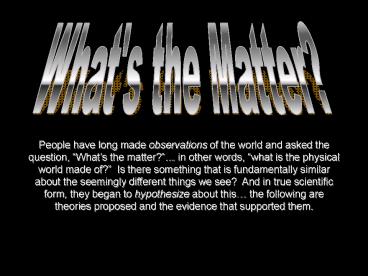What's the Matter - PowerPoint PPT Presentation
1 / 6
Title:
What's the Matter
Description:
While conducting an experiment (Gold Foil), Rutherford made a strange observation... Ernest Rutherford. Positive things in the center, negative around them ... – PowerPoint PPT presentation
Number of Views:36
Avg rating:3.0/5.0
Title: What's the Matter
1
What's the Matter?
People have long made observations of the world
and asked the question, Whats the matter? in
other words, what is the physical world made
of? Is there something that is fundamentally
similar about the seemingly different things we
see? And in true scientific form, they began to
hypothesize about this the following are
theories proposed and the evidence that supported
them.
2
John Dalton
- Dalton hypothesized that in reality, all physical
substances could only be divided a certain number
of times there came a point you could no longer
divide the substance to a smaller thing. This
thing was called atom after the Greek word for
indivisible.
Dalton imagined an indivisible sphere the atom
3
J.J. Thomson
- While conducting an experiment, Thomson observed
a strange phenomena. His hypothesis was that
these atoms of Daltons contained opposing
charges positive and negative. Thus, Thompson
proposed that the indivisible/fundamental atom
included bits of charge within it.
Thompson imagined an indivisible sphere the atom
with charges
4
Ernest Rutherford
- While conducting an experiment (Gold Foil),
Rutherford made a strange observation his
hypothesis included organizing where the charges
in the atom were located. He choose to assign
the to the things in the center and left the
to be organized around the center.
Positive things in the center, negative around
them
5
Niels Bohr
- While observing the light emitted from excited
gasses, Bohr hypothesized that the negative
things in an atom (electrons) were organized in
certain energy levels around the positive center
(protons neutrons).
Rutherfords model, plus specific levels for
electrons to orbit
6
Even Stranger...
- Numerous observations since Bohr leaves scientist
to think of electrons as incredibly strange space
filling things not quite a particle as once
thought but still negatively charged an
electron cloud organized around the nucleus of
protons and neutrons.
A cloud of negative electrons around the
protons and neutrons in the center































